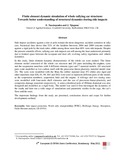JavaScript is disabled for your browser. Some features of this site may not work without it.
| dc.contributor.author | Nassiopoulos, Elias | - |
| dc.contributor.author | Njuguna, James A. K. | - |
| dc.date.accessioned | 2012-06-20T23:02:41Z | |
| dc.date.available | 2012-06-20T23:02:41Z | |
| dc.date.issued | 2012-06-21 | |
| dc.identifier.citation | E. Nassiopoulos and J. Njuguna. Finite element dynamic simulation of whole rallying car structure: Towards better understanding of structural dynamics during side impact. 8th European LS-DYNA® Users Conference, Strasbourg, 23-24 May 2011. | |
| dc.identifier.uri | http://dspace.lib.cranfield.ac.uk/handle/1826/7258 | |
| dc.description.abstract | Side impact accidents against a tree or pole remain the most dangerous accident scenarios in rally cars. Statistical data shows that 52% of the fatalities between 2004 and 2009 concern crashes against a rigid pole by the track sides, whilst among those more than 60% were side impacts. Despite the present scientific efforts, rallying cars side impacts are still among the least understood primarily due to limited space between the occupant and door sill, evolving safety regulations and vehicle dynamics. In this study, finite element dynamic characteristics of the whole car were studied. The finite element model consisted of the whole car structure and 241 parts including the engines, tyres and the suspension members with 4 different element types and 7 material models. All structural parts were modelled as low-carbon steel with the piecewise- linear-plasticity material model (mat 24). The tyres were modelled with the Blatz-Ko rubber material (mat 07) whilst also rigid and other materials (mat 020, 01, 09, S01 and S02) were used to represent different parts of the model, as the suspension members, suspension links and the engine. A rollcage and two racing seats were modelled with four-node shell elements and the use of piecewise-linear-plasticity and composite-damage materials respectively. A semi- cylindrical pole of 200mm diameter was also designed and modelled as a rigid body. The model was used to first investigate the dynamics of the crash, and later run a wide range of simulations and parametric studies in the cage, the car's floor and the seats. The important findings from the study are presented, conclusions drawn and scope for further development outlined. | en_UK |
| dc.language.iso | en_UK | - |
| dc.title | Finite element dynamic simulation of whole rallying car structure: Towards better understanding of structural dynamics during side impact | en_UK |
| dc.type | Conference paper | - |
Files in this item
This item appears in the following Collection(s)
-
Staff publications (SAS) [907]
